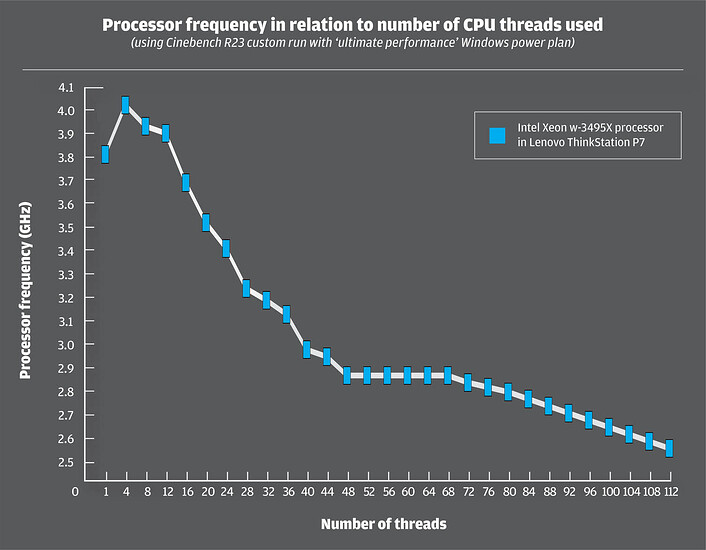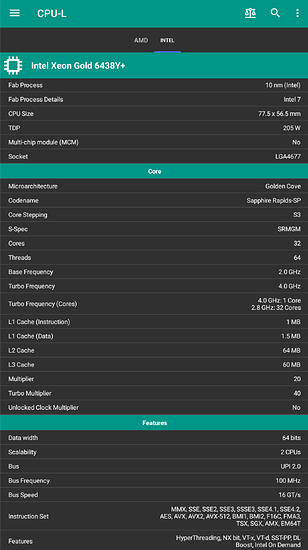Hello!
Registered here to ask a simple question.
The 4th gen Intel Xeon table servethehome. com/wp-content/uploads/2023/01/4th-Gen-Intel-Xeon-Scalable-Sapphire-Rapids-Launch-SKU-List.jpg has two columns—all cores turbo and max turbo.
But I need help finding information about the max and all turbo.
How many cores/threads can work on max Mhz simultaneously?
For example, 6438Y.
That depends entirely on the workload and the power budget. And there is a lot of different code out there, so you have to test this yourself. It’s different for each application.
The more cores you use, the less power each one can get. There is no way you run all core max boost on AVX512 code.
edit: If you want higher sustainable clocks, get a CPU with higher TDP. The 6458Q has 350W TDP and also 4GHz max boost. That CPU will be much closer to max boost on all core workload.
On 4th Gen. Scalable:
- Max Turbo is 1 core (2 threads) max boost
- All Cores turbo is maximum boost for when all cores are active
So in the case of 6438Y, it’ll be 4 GHz when only a single core (2 threads) is utilized, and 2.8 GHz when all cores are utilized. Anything from 2 cores to 31 cores will scale based on the fused ratio.
Welcome!
As others have said, unfortunately the granular core clock frequency vs core usage isn’t available anymore from manufactures (or wikipedia) because of how complex the behavior has gotten with frequency offsets happening depending on what type of workload a core is being used for as well as total thread usage.
The information does exist though, in more detailed reviews you will find it.
For example here’s the behavior for a w9-3495X in a lenovo system:
Although the graph isn’t the same for every CPU, it’s very similar behavior. Linear decrease the more cores are used and flatlining close to max cores and then slow decline after utilizing more and more SMT cores. This is how most CPUs behave.
And this is a CPU with up to 420W boost TDP, so very generous on TDP budget.
That is a good point.
Motherboard’s BIOS settings and version affect the clocking behavior as well.
But it’s mostly governed by TDP limits. Every Golden Cove core likes to get 30W each to run full tilt, we know this from Alder Lake desktop CPUs. It doesn’t work with 56 cores or it would melt your board because 1500A is no joke ![]()
Clock speed is nice and all…but you pay a lot for it. Bathtub curve is real. Cutting power by 50% only costs like 10-20% performance and allows many more cores to run. And this is exactly why we see declining clock speeds the more cores are utilized.
My Ryzen 7900x clocks down to 3.8GHz (way below 4.7Ghz base clock) if I set TDP to 65W and run AVX2 code. It’s that taxing and power consuming. The Xeon with the high power budget has a way more flat curve.
Very true.
I don’t know if it’s just me, but it seems like there are more and more options in modern BIOSes that kind of blur the line on what is considered overclocking or not; there are the obvious BIOS settings like PL that affect TDP, but there is weird stuff too like whatever ASUS’s “CPU Core Ratio” does.
slight tangent: did you guys see that AMD’s new threadripper 7000 series permanently fuses a register once you click accept on the overclocking warning in BIOS. Kind of reminds me of AMD PSB. I suppose this makes clear what is overclock and what isn’t.
Hardware-evidence for denying warranty. Yeah…“we only use these for security reasons asked for by customers” was the statement for vendor locked CPUs (TR from Dell, Lenovo,etc.).
I guess AMD found a new purpose for this technology. I was never the overclocking type, but I have to accept the BIOS warning page for enabling ECO mode (located in overclocking menu), so the definition is very vague.
That is what I’m afraid of.
Kind of reminds me of the “warrantee void” stickers manufactures would place over everything until most countries deemed them unenforceable.
On 3495x the default current limit is 550A, which is capable of boosting to around 3.7 GHz or so at PL1=PL2=500W (actual use is around 450W, so roughly 8W per core). Falcon Northwest and ASUS boards seem to set Current Limit and PL1/PL2 to unlimited by default, though, which I’m too scared to try.
An actual stock curve for 3495X looks something like this:
- Up to 2 cores: 48x
- Up to 6 cores: 44x
- Up to 10 cores: 43x
- Up to 18 cores: 42x
- Up to 26 cores: 38x
- Up to 36 cores: 34x
- Up to 46 cores: 31x
- Up to 56 cores: 29x
This explains so much. I guess that’s why I’ve never seen advertised turbo speeds. Just too much going on in the background for there ever being a situation where only a single core can boost up to advertised Hz.
Windows actually has a tendency to park all but 1 core (2 threads) on a very light workload. You can actually see it boost to maximum turbo clock sometimes. The Linux scheduler, on the other hand, is more spread out across all cores.
I have never seen the maximum turbo clock on Linux on my 3495x. During the stock config, I think the maximum I’ve got was around 4.4 GHz (<6c/12t). I modified my curve to boost to 4.6 GHz up to 16c/32t, and it has been happily boosting to that clock since.
How did you modify the curve? Is this only possible on Linux?
You can do this via the overclocking menu in the BIOS if your motherboard/CPU supports it. It’s the option with the name among the line of “By Core Turbo Ratio”.
Why does Intel suggest my CPU has a max Turbo of 4.6Ghz, but in BIOS it is set to 4.3Ghz? CPU-Z confirms that it’s boosting up to 4.3 only.
So I guess because all cores are enabled, the max boost gets reduced? Since it’s a non K processor, I can’t switch off any cores to increase the boost for a single core?
Intel CPUs have a concept of favored cores, where two of them can boost higher than other cores. It may be that 4.3 GHz is the non-favored core boost, and 4.6 GHz is two of the favored cores. (There may be two of 4.4 GHz/4.5 GHz boostable cores as well. This core boost depends on the configuration in each SKU.)
On Linux, you can check this via lscpu --extended, which will list a few cores with higher clocks than others. On Windows, I think HWiNFO (or other program that can read CPU info) can display it as well. For example, on my 3495X, core #21 and #25 can boost to 4.7 GHz, while #30 and #36 can boost to 4.8 GHz. The rest are 4.6 GHz.
It’s less about all-cores being enabled, but more in terms of cores in active use (i.e. C state stuff). On Windows, Intel XTU can show how many cores are in active use. Windows also actively parking cores, so you’re likely to see max boost more than on Linux.
I believe it’s possible to disable cores if you want to do that, probably something called “Core Disable Bitmap” or something similar in the BIOS. It shouldn’t require X CPUs. Though there’s not much reason to do this, as mentioned above.
Got it, thanks.
I just use the good old CPU-Z.
Nice CPU!


